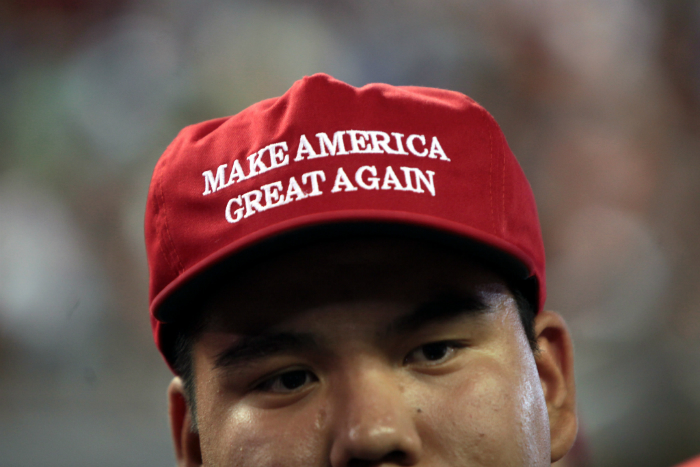
With the election of Donald Trump, lots of things we thought were tucked away on the dusty shelves of history appear to be back in vogue, and lots of things we thought we knew and understood to be true have been pretty much turned upside down.
Let’s set aside the politics of it all for a moment and look at this campaign purely from a marketing lens.
There’s a clarity in politics that other markets simply don’t have. If you’re selling, say, body wash or gluten free granola bars, you have marketshare and a host of other metrics to try to gauge winning and losing.
In an election, it’s much more definitive. Trump won, Hillary lost. That kind of clarity can perhaps help shed some light on the effectiveness of their respective marketing efforts.
There are no doubt a multitude of reasons as to why the outcome was what it was, but marketing was certainly a factor and there are some takeaways for those of us who do this for a living.
There was a weird, dreamlike quality to this campaign, with its logic and flow requiring a constant suspension of disbelief.
Hillary Clinton ran a campaign that reflected her own personal brand – serious and wonkish, with 35-point plans and shifting slogans that sounded like they’d been developed by committee and filtered through a PowerPoint presentation.
Likewise, Donald Trump’s zig-zagging, free-wheeling campaign felt like the embodiment of his personal brand, so much in fact that it was difficult to tell where one ended and the other began.
It was also a campaign featuring by far the two most disliked major party candidates, in terms of favorability ratings, in the history of Presidential politics and yet none of us could get enough of it.
It was both a train wreck and a ratings bonanza.
Advertising from another era?
There was also an oddly throwback feel to Trump’s message. “Make America Great Again” was, of course, in itself a plea to return to an undefined bygone era.
But the way in which it was used also felt like it came from a different time. That simple phrase repeated over and over felt reminiscent of the old Unique Selling Proposition (USP), a
tool created in the 1940s that dominated product advertising for decades and never completely went away, like a Swanson’s TV dinner pulled out of the basement freezer.
The simplicity and repetition of the USP has an easy appeal. You start with the product, its features and benefits, and figure out what’s the claim you can make that none of your competitors can.
Then you drill it into consumers’ heads until they can repeat it in their sleep.
The USP eventually fell out of favor in the ad world for a few reasons.
One was that it felt inherently backwards. The USP starts with the product and how you want to sell it rather than with understanding the consumer and what or she needs to hear and feel in order to buy.
The USP tool isn’t particularly complex or nuanced. It doesn’t reflect a sophisticated understanding of the modern consumer.
I happen to believe that consumers are not and never have been the 2-dimensional simpletons that advertisers took them to be for decades, especially not now in the digital age.
Then again, I’ve seen firsthand countless examples of the creative process getting a little too clever for its own good.
The simplicity of the USP can be effective in the same way a bad jingle can stick in your head.
Filling in the blanks
Was “Make America Great Again” an example of a USP?
Sort of, but not exactly. I think there’s more to it.
Nowadays, we marketers like to talk about advertising and brand building as a storytelling exercise.
Hammering home a product benefit might be good salesmanship, but it doesn’t make for much of a story. You need characters and conflict, rising and falling action and some kind of conclusion.
To really hit home, you need texture and oftentimes subtlety. You have to trust your audience to fill in some of the blanks.
“Make America Great Again” actually works on this level even though it might not seem like it should.
It’s why some people found it so maddening, preposterous, maybe even deeply offensive. And it’s why others connected with it instantly.
It is deceptively layered. It implies that there was a time when America was once great, that that time has passed, and that there is some new path that can take us to the Promised Land again.
The slogan begs a lot of questions. Like, what does any of it even mean? What does it mean to be “great” and when, if ever, did we meet that criteria? How are we not measuring up now? Finally, what do we need to do to get back on track?
These are questions perhaps reporters and debate moderators could have asked.
Whether it was intentional, random, or just good luck, the real power of “Make America Great Again” might be that none of those questions were ever answered. It was all left completely blank, open to interpretation.
The consumer, in this case the voter, got to fill in the details.
What goes unsaid
When we’re tasked with telling a brand story at The New BLK, we start by searching for something authentic, something real that we think an audience will connect with and feel something when they see it, read it or hear it.
It’s easy to forget sometimes the impact of what goes unsaid. Perhaps it is fitting in this era of the 140 character limit and a candidate who couldn’t get enough of it that brevity and simplicity in telling a brand story would be a winning formula.
It brings to mind the legend of the greatest six word story of all time: “For sale, baby shoes,never worn.”
In this “post-facts” world, it’s also worth noting that the story was falsely attributed to Ernest Hemingway but hardly anyone ever remembers that part.
Eric Gautschi is Managing Partner/Creative Director at The New BLK. The New BLK is an ad agency, creative think tank, and content production studio based in Omaha.




